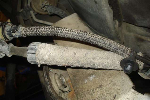At 40 psi you will be getting better mileage but you are going to run the inside of your treads off way before the outside. I cannot see how you can get increased tire mileage that way. The tradeoff of better gas mileage over tire life may make it worth it at today's pump prices, but you have to be experiencing a much rougher ride.
There is a trick you can do to determine precisely how much pressure to keep in your tires for your particular vehicle. It will give you the best tradeoff possible between mileage, tire life, and comfort. Make sure you use an accurate tire guage so that once you learn this pressure you know it is correct.
With a cold vehicle and cold tires, air them up way over pressure. 40 psi would certainly be there. Take a chalk and mark a chalk line sideways across the tread of a front and rear tire. Drive your vehicle several yards (30-60 or so should do it). Now look at the chalk marks.
You should see the inside of the chalk marks worn off but the outsides should still be showing. In other words, the bowed out overinflated tire was wearing the middle of the tread and not touching the outside of the tread.
Release a couple of pounds of pressure from the tires and repeat the experiment. Continue until the complete chalk marks wear evenly. (You might want to lose another pound to make sure the entire tire is bearing down across the tread once the entire chalk mark disappears at the same time). You have now determined the tire pressure at which you are keeping the entire tread on the road.
Under this pressure you are wasting available fuel economy, generating excess heat, and prematurely wearing the tread. Over this pressure you will get better mileage at the cost of comfort and decreased tread life. Keeping at this pressure will wear the tire evenly and thus extend its life to its greatest extent and offer the best compromise possible between gas mileage, comfort, and safety (you'll have your whole tread on the road). The pressures may be a couple of pounds different between front and back for your particular vehicle application.
A caveat: this needs to be done on NEW tires as soon as you buy them. If you have already logged 25,000 miles on overinflated tires all you will be doing is verifying the exceessive pressure you have already been using (in other words, the chalk line will wear evenly even though the middle of the tread may be quite a lot shallower than the outside tread).
[Edited by GJarrett on 11-30-2000 at 07:18 AM]










